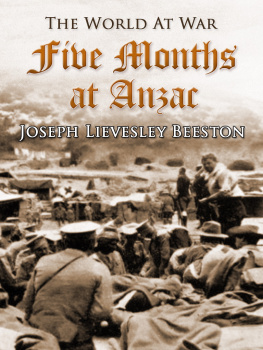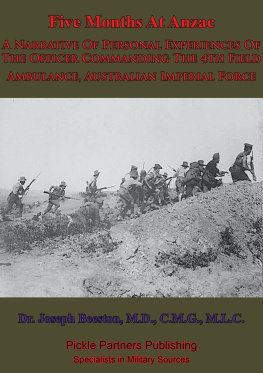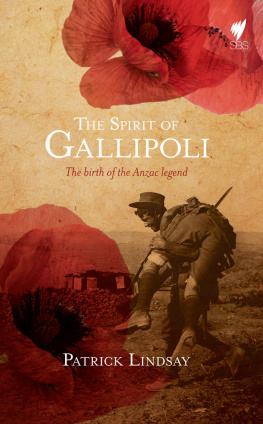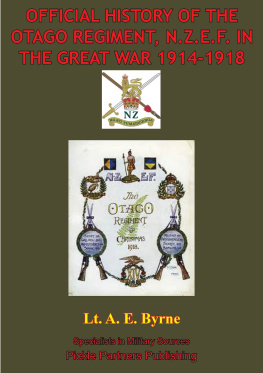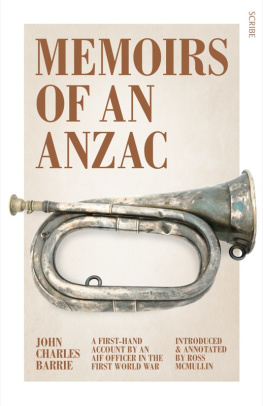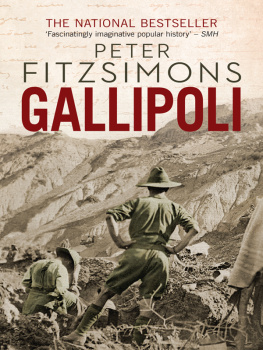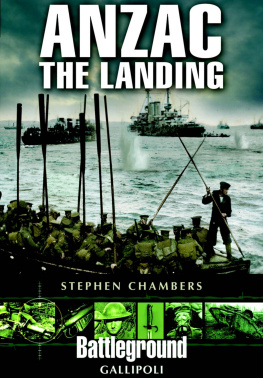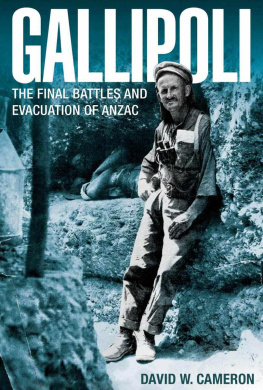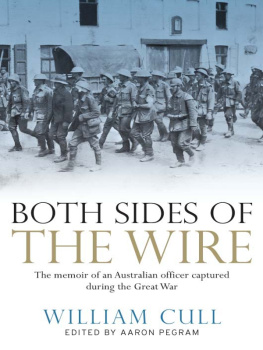Joseph Lievesley Beeston - Five Months at Anzac
Here you can read online Joseph Lievesley Beeston - Five Months at Anzac full text of the book (entire story) in english for free. Download pdf and epub, get meaning, cover and reviews about this ebook. year: 2016, publisher: Otbebookpublishing, genre: Non-fiction. Description of the work, (preface) as well as reviews are available. Best literature library LitArk.com created for fans of good reading and offers a wide selection of genres:
Romance novel
Science fiction
Adventure
Detective
Science
History
Home and family
Prose
Art
Politics
Computer
Non-fiction
Religion
Business
Children
Humor
Choose a favorite category and find really read worthwhile books. Enjoy immersion in the world of imagination, feel the emotions of the characters or learn something new for yourself, make an fascinating discovery.
- Book:Five Months at Anzac
- Author:
- Publisher:Otbebookpublishing
- Genre:
- Year:2016
- Rating:5 / 5
- Favourites:Add to favourites
- Your mark:
- 100
- 1
- 2
- 3
- 4
- 5
Five Months at Anzac: summary, description and annotation
We offer to read an annotation, description, summary or preface (depends on what the author of the book "Five Months at Anzac" wrote himself). If you haven't found the necessary information about the book — write in the comments, we will try to find it.
Five Months at Anzac — read online for free the complete book (whole text) full work
Below is the text of the book, divided by pages. System saving the place of the last page read, allows you to conveniently read the book "Five Months at Anzac" online for free, without having to search again every time where you left off. Put a bookmark, and you can go to the page where you finished reading at any time.
Font size:
Interval:
Bookmark:

ANZAC COVE.
Photo by Lieut.-Col. Millard.
C.M.G., V.D., L.R.C.S.I., Colonel A.A.M.C. Late O.C. 4th Field Ambulance, late A.D.M.S. New Zealand and Australian Division
SYDNEY
ANGUS & ROBERTSON LTD.
89 CASTLEREAGH STREET
1916
DEDICATED TO
THE OFFICERS, NON-COMMISSIONED OFFICERS AND MEN OF THE 4th FIELD AMBULANCE, A.I.F., OF WHOSE LOYALTY AND DEVOTION TO DUTY THE WRITER HEREBY EXPRESSES HIS DEEP APPRECIATION.
Shortly after the outbreak of Warafter the first contingent had been mobilised, and while they were undergoing trainingit became evident that it would be necessary to raise another force to proceed on the heels of the first. Three Infantry Brigades with their Ambulances had already been formed; orders for a fourth were now issued, and naturally the Ambulance would be designated Fourth Field Ambulance.
The Fourth Brigade was composed of the 13th Battalion (N.S.W.), 14th (Victoria), 15th (Queensland) and 16th (Western Australia)commanded respectively by Lieutenant-Colonel Burnage, Lieutenant-Colonel Courtnay, Lieutenant-Colonel Cannon and Lieutenant-Colonel Pope. The Brigade was in charge of Colonel Monash, V.D., with Lieutenant-Colonel McGlinn as his Brigade Major.
As it will be necessary from time to time to allude to the component parts of the Ambulance, it may be as well to describe how an ambulance is made up. It is composed of three sections, known as A, B, and C, the total of all ranks being 254 on a war strength. It is subdivided into Bearer, Tent and Transport Divisions. Each section has its own officers, and is capable of acting independently. Where there is an extended front, it is frequently desirable to detach sections and send them to positions where the work is heaviest.
As the name implies, the Bearers convey the wounded to the dressing station (or Field Hospital, as the case may be). Those in the Tent Division dress the cases and perform nursing duties, while the Transport Division undertakes their conveyance to Base Hospital.
It was decided to recruit the Fourth Field Ambulance from three States, A Section from Victoria, B from South Australia, C from Western Australia. Recruiting started in Broadmeadows, Victoria, on the 19th October, 1914, and thirty men enrolled from New South Wales were included in A Section. Towards the end of November B Section from South Australia joined us, and participated in the training. On the 22nd December we embarked on a transport forming one of a convoy of eighteen ships. The nineteenth ship joined after we left Albany.
Details from the Ambulance were supplied to different ships and the officers distributed among the fleet. Our last port in Australia was Albany, which was cleared on the last day of 1914a beautiful night and clear day, with the sea as smooth as the proverbial glass.
The convoy was under the command of Captain Brewisa most capable and courteous officer, but a strict disciplinarian. To a landsman, his control of the various ships and his forethought in obtaining supplies seemed little short of marvellous. I had the good fortune to be associated with Captain Brewis on the passage from Colombo to Alexandria on board the and his friendship is a pleasant memory.
The fleet was arranged in three lines, each ship being about three lengths astern of the one ahead. The sight was most inspiriting, and made one feel proud of the privilege of participation. The towed the submarine AE2, and kept clear of the convoy, sometimes ahead, then astern, so that we viewed the convoy from all points.
The day after leaving Albany a steamer, which proved to be the , joined us with C Section of our Ambulance. Signals were made for the to move ahead and the to drop astern, the moving into the vacant place. The manoeuvre was carried out in a most seamanlike manner, and Captain Young of the received many compliments on his performance.
Three days later a message was flagged from the that Major Stewart (who commanded the C Section of the Ambulance) was ill with enteric, and that his condition was serious. The flagship then sent orders (also by flag) "Colonel Beeston will proceed to and will remain there until next port. to provide transport." A boat was hoisted out, and Sergeant Draper as a nurse, Walkley my orderly, my little dog Paddy and I were lowered from the boat deck. What appeared smooth water proved to a long undulating swell; no water was shipped, but the fleet at times was not visible when the boat was in the trough of the sea.
However, the was manoeuvred so as to form a shelter, and we gained the deck by means of the companion ladder as comfortably as if we had been in harbour. Major Stewart's illness proved to be of such a nature that his disembarkation at Colombo was imperative, and on our arrival there he was left in the hospital.
The heat in the tropics was very oppressive, and the horses suffered considerably. One day all the ships carrying horses were turned about and steamed for twenty minutes in the opposite direction in order to obtain a breath of air for the poor animals. In the holds the temperature was 90 and steamy at that. The sight of horses down a ship's hold is a novel one. Each is in a stall of such dimensions that the animal cannot be knocked about. All heads are inwards, and each horse has his own trough. At a certain time in the day lucerne hay is issued. This is the signal for a prodigious amount of stamping and noise on the part of the animals. They throw their heads about, snort and neigh, and seem as if they would jump over the barriers in their frantic effort to get a good feed. Horses on land are nice beasts, but on board ship they are a totally different proposition. One intelligent neddy stabled just outside my cabin spent the night in stamping on an adjacent steam pipe; consequently my sleep was of a disturbed nature, and not so restful as one might look for on a sea voyage. When he became tired, the brute on the opposite side took up the refrain, so that it seemed like Morse signalling on a large scale.
We reached Colombo on the 13th January, and found a number of ships of various nationalities in the harbour. Our convoy almost filled it. We were soon surrounded by boats offering for sale all sorts of things, mostly edibles. Of course no one was allowed on board.
After arranging for Major Stewart's accommodation at the hospital, we transferred from the to the . The voyage was resumed on the 15th. When a few days out, one of the ships flagged that there were two cases of appendicitis on board. The convoy was stopped; the ship drew near ours, and lowered a boat with the two cases, which was soon alongside. Meanwhile a large box which had been made by our carpenter was lowered over the side by a winch on the boat deck; the cases were placed in it and hoisted aboard, where the stretcher-bearers conveyed them to the hospital. Examination showed that operation was necessary in both cases, and the necessary preparations were made.
The day was a glorious onenot a cloud in the sky, and the sea almost oily in its smoothness. As the hospital was full of cases of measles, it was decided to operate on deck a little aft of the hospital. A guard was placed to keep inquisitive onlookers at a distance, and the two operations were carried out successfully. It was a novel experience to operate under these conditions. When one looked up from the work, instead of the usual tiled walls of a hospital theatre, one saw nothing but the sea and the transports. After all, they were ideal conditions; for the air was absolutely pure and free from any kind of germ.
Next pageFont size:
Interval:
Bookmark:
Similar books «Five Months at Anzac»
Look at similar books to Five Months at Anzac. We have selected literature similar in name and meaning in the hope of providing readers with more options to find new, interesting, not yet read works.
Discussion, reviews of the book Five Months at Anzac and just readers' own opinions. Leave your comments, write what you think about the work, its meaning or the main characters. Specify what exactly you liked and what you didn't like, and why you think so.

